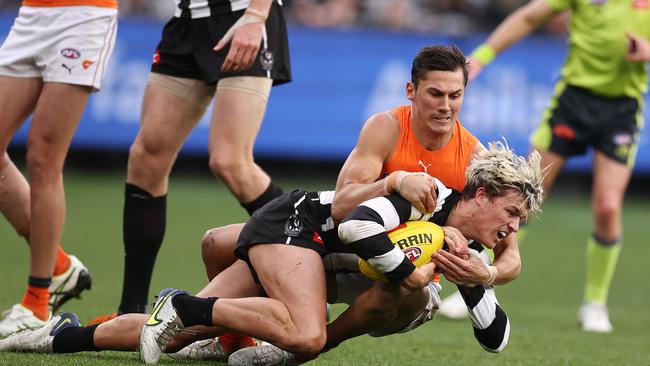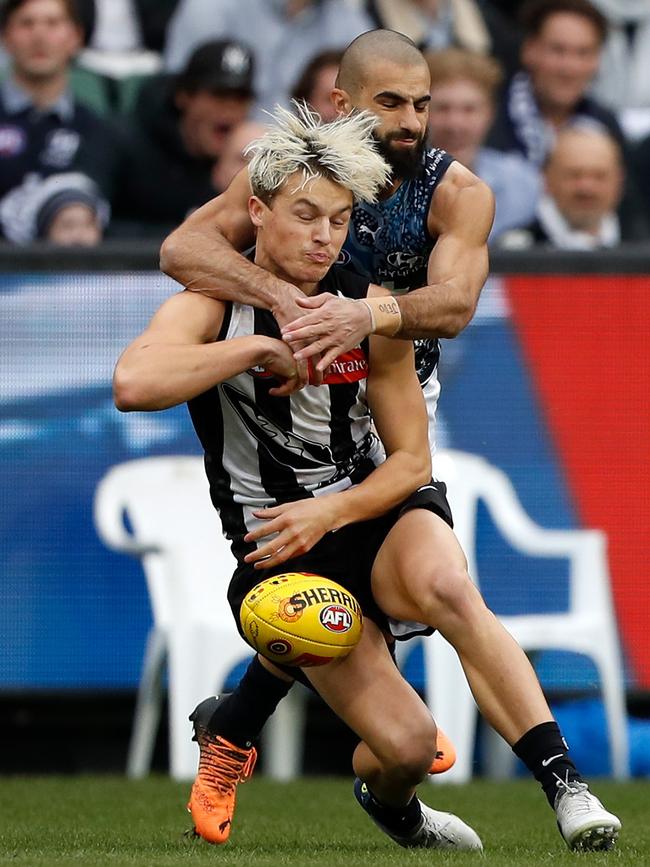AFL news: Dermott Brereton on Jack Ginnivan, ducking tackle technique to draw free kicks
Junior footballers – the next stars of our game – have long been inspired by their AFL heroes. But what the 12-year-olds out there are learning now is wrong, writes Dermott Brereton.

AFL
Don't miss out on the headlines from AFL. Followed categories will be added to My News.
11-year-old Scotty Pendlebury and a 12-year-old Eddie Betts.
And these young 10 to 12-year-old’s out there are learning from their footballing heroes.
When Pendlebury gets the ball, the world around him slows down. He has taught himself to find space where there is none and take a microsecond to assess all options.
Cyril Rioli had the most amazing escape routes pre-planned in order to get out of any and every tight situation. His feet were so fast. He never loaded up his weight on any
one foot. He landed both feet equally balanced and ended up exiting tackling traffic
through the most unlikely escape route.
Eddie Betts had the ability to spin away from tacklers towards the boundary line.
Most pursuers then believed him to be boxed in and corralled into a non-scoring position. Time and time again, he left them with egg on their faces.
As a young teenager I watched a young dancing Dougie Hawkins, the pirouettes of Robbie Flower, the pure artistry of balance that was Keith Greig and the man that would be known as the Macedonian Marvel, Peter Daicos.
Watch every blockbuster AFL match this weekend Live & Ad-Break Free In-Play on Kayo. New to Kayo? Try 14-Days Free Now >
These men and their ability to avoid the tackler is as much a highlight of our game as
the spectacular high mark, or the freakish goal.
But the 12-year-olds out there now are being inspired differently. They are being
shown a “short cut”. They are watching and learning to take a huge step into a tacklers path, drop their trailing knee to the ground, corkscrew their shoulders downwards and use their arms to ride the tacklers arms up to the neck, in an endeavour to milk a free kick.
They are not teaching themselves evasive techniques such as Rioli and Pendlebury exemplified. They are not employing an agility ladder on the ground at training, to give their muscular memory a chance to avoid being clobbered.


They are teaching themselves to exploit the safety clause of the rules in order to win a free kick. And it is fundamentally just wrong.
It has been several years since I coached junior teenagers. And even back then, some
of my boys were inspired by the bravery of Joel Selwood and his ability to win head high free kicks. When any of my boys attempted this action on field, (which some were quite good at) I would send the runner out and take them from the field.
I would educate them that the art of evasion and not getting hit, is by far a more valuable asset than that one free kick received.
Add to that, if it is your “go to” action and you find the ball a bit, by the time you are in the middle of your adult football career, you will be hit in the head hundreds upon hundreds of times. So there is a duty to of care, to steer juniors away from the action.
And I struggle to understand why a player would make an action that puts his entire fate in the interpretation of the umpire for that moment.
As for the spirit of the game, a game that is proud to be a robust tackling game, a player cradles his tackling arm to make the catch against an opposition.
But when the opposition is Jack Ginnivan, Errol Gulden, Jimmy Rowe or any of the many other recidivists, they will lower their body height and then that tackling arm makes contact with the area that would have been the hips and or lower rib cage for the standing height of the recipient.
And this is on the “tackled” player. He is the one that has deliberately lowered into the contact, when there is no sound reason to do so, other than the exploitation of the rule.
On that notion, I cannot see the logic to suggest that the action is any different to that of ducking into a tackle. Both actions seek to invite head high contact by the initiative of the tackled player.

On a game visual, free kicks between ruckman are the most commonly delivered free
kicks (but they are an entire different world which no umpire seems to truly understand). But right now the most common free kick in general play, is head high contact. It never use to be.
Patrick Cripps has the highest number of free kicks received in the AFL for any one action, other than head high tackle free kicks. He has been awarded 9 free kicks for being held at the stoppage and he is around the footy a lot, he averages 25 disposals per game.
By contrast, Jack Ginnivin has received double the amount in 18 head high free kicks, yet he averages just 10 disposals per game.
Ginnivin is the poster boy for this strategy, but he doesn’t have the sole rights to it.
The admirable Matty Rowell draws these free kicks. Even one of my favourites Dylan
Moore employs the tactic. So there is to be no scorn directed towards young Jack and
the others. They are maximising their endeavours in an area that they are not quite as
good as some others. And that is totally understandable while there is a get out clause
within the rule.
But with so many performing this action now than ever before: Is this really how we want our game to look?
We have a duty of care for the safety of our players. And that includes keeping some
players safe from themselves. But we also have a duty to keep the game as attractive
as possible, when possible.
CONCUSSION EXPERT’S WARNING ON GINNIVAN TACKLE TECHNIQUE
A leading concussion researcher says Collingwood has a “duty of care” to ensure forward Jack Ginnivan stops trying to draw free kicks, labelling his technique as “potentially quite dangerous”.
The young Magpie, who has received the most free kicks for high tackles of any player in the AFL this year, has a penchant for lowering the body and lifting his arm, drawing headhigh contact from opponents.
The 19-year-old is only a second-year player, and Associate Professor Dr Alan Pearce from NeuroSports Labs warned of the potential long-term impact of continuing to play this way.
“The concern we have more than concussions is the long-term dangers or outcomes of repeated impacts to the brain, which are not necessarily concussions,” he said.
“So what Jack’s doing is potentially quite dangerous in the long-term, even though there may not be any effects that we see immediately like a concussion.”
Watch every blockbuster AFL match this weekend Live & Ad-Break Free In-Play on Kayo. New to Kayo? Try 14-Days Free Now >
Dr Pearce urged the Magpies to help ensure Ginnivan’s long-term health by correcting his technique now.
“The long-term outcomes we’re referring to is obviously the risk of CTE,” he said.
“And we know from the data worldwide to date that it is a disease of exposure, so the more you’re exposed to impacts to the head or the neck that are not concussions, that’s the risk that we’re concerned about.
“His coaches need to have a think about that from a health perspective as much as they would from a technique aspect.
“He’s still young enough to revise techniques, and I think his coaches have a duty of care to try and coach him in a better way that’s I guess beneficial for his long-term health.”

GWS Giants coach Mark McVeigh said he expected the AFL to address the tackling issue at season’s end.
“It is an interesting one right now where it sits for me, obviously kids will be looking at it and trying to draw that free-kick,” McVeigh told AFL 360.
“You would like to think there will be some sort of clarification around it come year’s end.
“From our point of view right now we have to embrace that players are going to do it and we have to try and make sure our tackling technique is as good as it possibly can be so we actually train our players to come up against it.
“Players will try and do it at training and we’re trying to nullify it so it’s at an interesting moment in football.”
McVeigh said Ginnivan was “playing within the rules” at the moment so the onus was on tacklers to get it right.
Hawthorn coach Sam Mitchell said incentivising the right things in the game was important.
“The concept of trying to get hit high to earn a free-kick doesn’t fit in the concussion protocols,” Mitchell said.
“Certainly we encourage our players to be tough physical players and if you can draw a free-kick by earning a free-kick … we talked about it before the game against the Giants actually that the free-kick count is done by being lower, harder, tougher and try to earn free-kicks by being lower and harder.
“There are some players, we’re talking about Ginnivan here, he is the best at what a lot of players are doing.”

Collingwood coach Craig McRae said in his post-match press conference that he believed Ginnivan should have been paid a free kick for some incidents in the clash against North Melbourne.
“The last time this happened against Hawthorn, I just got the answers that they missed a couple,” he said post-match.
“It looked like a high tackle that wasn’t called.”
Swans coach John Longmire said on Monday the onus was on an individual player to protect themselves.
“I think if they are there then pay the free kick, and if they’re not then don’t,” Longmire said.
“If a player ducks and draws the free kick or tries to draw the free kick, I think that’s the challenge for that particular player to get right because we don’t want players hurt.”
More Coverage
Originally published as AFL news: Dermott Brereton on Jack Ginnivan, ducking tackle technique to draw free kicks




